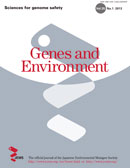The primary motivation for conducting short-term tests for environmental mutagens and carcinogens has been to predict mutagens and/or carcinogens and to assess any associated risks. Organ-specific
in vivo short-term tests in rodents are valuable because chemical carcinogenesis is generally organ-specific. I have attempted to develop various organ-specific
in vivo short-term tests mainly in rodent liver and stomach. Recently, our collaborative study group, Toxicogenomics/Japanese Environmental Mutagen Society·Mammalian Mutagenicity Study Group (JEMS·MMS), attempted to use gene expression profiling in
in vivo short-term tests, conducted DNA microarrays to extract candidate marker genes, and later shifted to quantitative real-time PCR (qPCR) to profile the expression of selected genes. We successfully discriminated 8 genotoxic hepatocarcinogens from 4 non-genotoxic hepatocarcinogens by statistical analysis using principal component analysis (PCA) based on the gene expression profiles for 12 genes (
Aen,
Bax,
Btg2,
Ccnf,
Ccng1,
Cdkn1a,
Gdf15,
Lrp1,
Mbd1,
Phlda3,
Plk2, and
Tubb2c) in mouse liver at 4 and 48 h following a single intraperitoneal administration of chemicals as determined by qPCR. More recently, we successfully performed a similar study in rat liver. Previously, my collaborators and I developed various organ-specific
in vivo short-term test methods, including UDS (unscheduled DNA synthesis); RDS (replicative DNA synthesis) using a liquid scintillation counter in rat glandular stomach, forestomach, colon, and liver and hairless mouse epidermis; DNA single-strand scission (DSS); and ornithine decarboxylase assay (ODC) in rat glandular stomach on 62 compounds. Developing short-term tests that are helpful for the risk assessment of human mutagens and carcinogens would contribute to the development of ideal prediction methods.
抄録全体を表示
